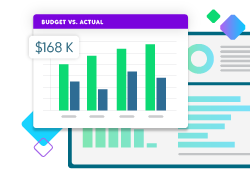3 Strategies to Build Your Organization’s Financial Capacity

Let’s face it—budget planning can cause a lot of stress and anxiety for nonprofits. Do we have the funds this year to maintain our programs? And what do we do if the answer is “no”?
Most organizations face frequent budget cuts, which creates organizational uncertainty and a scramble for new funding options.
But what if your organization could engage in a more thoughtful and systematic practice to build your organizations’ financial capacity without making this tradeoff? Building your organization’s financial capacity involves investing in solid financial systems, but also engaging in more strategic board governance and leadership.
Here are three strategies your organization can use to build its capacity to plan for more resources—not fewer—to meet its mission.
1. Develop a more accurate overall budget
In collaboration with your organization’s finance committee, create a more accurate overall budget by using project or program-based budgets. For each program, break down its actual revenue and expenses, including its necessary overhead, such as your staff’s time devoted to office administration, marketing and fundraising for such program.
Calculating indirect costs can be challenging. Instead of assigning a random percentage to your programs, ask your employees to start tracking how they spend their time so that the organization can make more accurate allocations. Program-based budgets will allow your organization to make more precise cash flow projections and more appropriate fundraising goals for the year so that your organization can plan to accomplish more, not less.
Analyzing your budget this way also allows you to understand the ROI of each program. You can clearly see which revenue sources or grant-funded parts of your organization might be draining your budget instead of adding to it. Just because a program takes more from your budget than it gives doesn’t mean it needs to be cut. But it does need to be part of a larger, intentional conversation about being a revenue-wise organization.
2. Utilize a dashboard to communicate financial updates
A dashboard is a helpful tool for board members and staff to stay abreast of the organization’s finances. A dashboard is a snapshot of the organization’s progress towards its major financial, fundraising, and mission impact goals. It can be especially helpful for those board or staff members who don’t have time—or interest—to decipher large spreadsheets.
You can build a simple dashboard with formulas and pivot tables in Microsoft Excel. Once you have a template built, you simply update the numbers in the formula tab and the visuals and graphics on the dashboard tab will update automatically.
Also check your fund accounting software for opportunities to share presentation-ready dashboards or even give certain staff members view-only access. It is a great tool for building understanding and stimulating greater discussion around the organization’s finances, whether you are a board member or staff member certified as a professional accountant or a total novice.
3. Engage board members and staff in stewarding finances
Your organization’s finances should be discussed at every board meeting, but they should also be discussed in select staff and committee meetings, as appropriate. When your board members and staff are educated about the organization’s finances, they take greater ownership over their own departments’ budgets and often recommend creative, cost-saving solutions.
This greater sense of ownership in turn fosters a greater sense of commitment and therefore improves morale—board members and staff really feel that their opinion and suggestions contribute to the organization’s well-being. Conversations about the organization’s finances do not have to elicit fear and anxiety—even when the numbers aren’t great. Talking about appropriate metrics with your team could help your organization shed the fear-based mentality and create a culture of transparency.
Fund Accounting Software that Drives Impact
Find out how Blackbaud’s Financial Edge NXT® fits your organization.

Capacity Building Strategies to Work Smarter, Not Harder
Implementing program-based budgets, a dashboard, and engaging board and staff in stewarding your organization’s finances will position your organization to make more educated decisions about its finances. Greater engagement will also open up more opportunities for board giving and getting, as well as opportunities to brainstorm cost-saving solutions. These three strategies will create more valuable resources to reach your organization’s mission, allowing it to work smarter, not harder.
This post was originally published in March 2015 and updated in April 2024.
